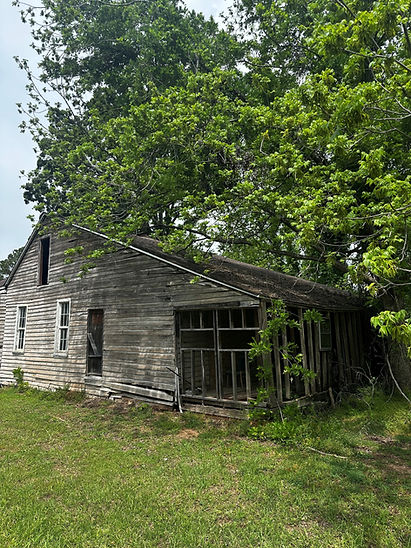The Pottersville House
Located on the outskirts of Edgefield is a property known as the Pottersville House. This structure dates to the late 1700s to early 1800s and is located in the close vicinity of the Pottersville kiln site, built in 1810 by Abner Landrum. Abner and John Landrum are credited with introducing Edgefield Pottery to much of North America through their potteries located in Edgefield.
This property was donated to Preservation South Carolina in 2019. Having been vacant for over three decades, the house had undergone considerable deterioration of its interior and exterior. The House is presently owned by the Town of Edgefield, which also possesses the adjoining property where the Dr. Arthur and Esther Goldberg Groundhog Kiln is located.
In the early 1800s, the Landrum family settled in what was then called Edgefield District, now Edgefield County. The Landrum's, like many others in the area, owned slaves who helped run their plantations and businesses. In 1810 Dr. Abner Landrum built an entire community around the slave production of stoneware pottery, referred to as Landrumsville, and later recognized as Pottersville.

1817 Map of Edgefield, SC
Pottersville made use of the abundant red clay and kaolin deposits in the region. Kaolin was, and still is, used for a number of practical purposes, such as Kaopectate, toothpaste, and paint pigment. In stoneware pottery, this white clay allowed for the addition of decorative elements to the red-clay pots and jars. Edgefield District potters made use of the kaolin, sand, pine, and feldspars naturally available to them. These elements were essential to Edgefield's pottery production. Edgefield pottery was at the apex of economic, industrial, political, social, and artistic development in 19th century SC.
By 1832, Pottersville quickly grew to a village of approximately 150 and soon earned a reputation for producing inexpensive, sturdy, and beautiful stoneware. By the 1840s, numerous families had begun similar operations and Edgefield gained greater renown for its pottery. Enslaved labor was still heavily relied upon, and a handful of skilled artisans stood out among them, including David Drake.

The MET Exhibit: Hear Me Now: The Black Potters of Of Old Edgefield, South Carolina

Signed David Drake Piece
April 12, 1858
Drake, also known as "Dave the Potter", was born around 1800. Drake was among the relatively few literate slaves of his time, perhaps having been taught to read by his first owner, Harry Drake. Although it was against the law to educate slaves for fear that literacy would spark free will and potential uprising, many owners taught their slaves to read so they could study the Bible. Dave's literacy allowed him to mark many of his pots with a signature and date, or more rarely, a rhyming couplet or short poem. Today, David Drake pieces are highly sought after and can be found in exhibits within The Charleston Museum, The McKissick Museum, The International African American Museum, and The Metropolitan Museum of New York.
SEPTEMBER 2024 We are pleased to share that the Town of Edgefield has purchased the Pottersville House and obtained a grant from the South Carolina Department of Parks, Recreation & Tourism. The objective of this grant is to ensure the sustainability of the Edgefield Stoneware industry, with the Pottersville House playing a pivotal role in the effort, given its distinction as a structure from the Town's early pottery history.
The long-term plan for the property, located one mile from the historic Town Square, is to launch a sustainable pottery heritage tourism site, featuring a Living History Museum, a potter-in-residence studio, and active use of the existing city-owned Groundhog Kiln.
The Town of Edgefield Acquisition
In September 2024, Preservation SC sold the Pottersville House to the Town of Edgefield. The town applied for - and received - a grant from the SC Department of Parks, Recreation and Tourism (SC PRT) to: (1) begin initial stabilization activities; and (2) promote tourism strategies with a focus on Edgefield pottery.
Even with this financial support and significant volunteer involvement from the Town of Edgefield and its residents, there are still enormous obstacles. The structure’s foundation, windows, and exterior siding have rapidly decayed, leaving the house extremely vulnerable to the elements.
In December 2024, the Town received a stabilization and weatherization planning grant from the SC Department of Archives and History.

OUR MISSION
We remain committed to this historic property and its stabilization and will continue to engage with the Town in implementing this project.




